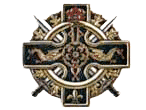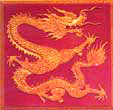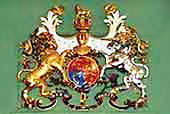|

from
RoyalHouseOfStewart Website
Contents
INTRODUCTION
The Hungarian Order of
the Dragon is currently registered at the High Court of Budapest as
The Imperial and Royal Dragon Court and Order - Ordo Draconis,
Sárkány Rend, 1408.
-
The Grand Chancellor is
Chev. Dr. Gyorgy von
varhegyi Lehr, Count of Oberberg, with Inner Court members including:
-
HRH Prince Michael of Albany, Head of the Royal House of Stewart and Fons Honorum of the Order,
-
Grand Duke Peter Galicin of Carpathia and
-
Baron Wodiank Zoltan Nemessary.
-
Bishop Bela Csernak is the Grand
Prior in Transylvania and Chev.
-
Baron Andreas G. von Lehr the
Grand
Prior in Germany.
Other notable members are
-
Count Monsignor Laszlo Esterházy
-
Chev. Count Dr Janos szeki Teleki
-
Chev. Monsignor
Laszlo von galantal Esterházy, Papal Chaplain, Provost Parochus of
the Mariaremete Cathedral in Budapest
In the English speaking world
the Order resides within the Protectorate of the Royal House of
Stewart, with the Grand Prior in Britain being:
-
Chev. Dr. Andrew von
Zsigmond, Baron de Lemhény, Honorary Consul of Hungary in Liverpool
-
Viscount Richard Wright Hogeland being the Grand Prior for all
other English speaking countries

Insignia of The
Imperial and Royal Dragon Court and Order
Back to Top
THE HUNGARIAN
COURT AND ORDER
Long afterwards, on 13 December 1408 (when England was in her
Plantagenet era and the Stewarts were the rulers of Scotland), the
fraternal aspect of the Dragon Court was formally reconstituted by
King Szigmond von Luxembourg of Hungary at a time of wars and
general political turmoil. Having inherited the ancient legacy in
1397, he drew up a pact with twenty-three royals and nobles who
swore to observe 'true and pure fraternity' within the 'Societas
Draconis' (Society of the Dragon) - a style which later became "Ordo
Draconis" (Hungarian: Sárkány Rend - Order of the Dragon), although
the Court was by no means a conventional Order in the recognized
chivalric sense.
Along with Szigmond (Sigismund), other officers of the Court were
his second wife Barbara Cilli (daughter of Duke Hermann II of Styria)
and their daughter Elizabeth, thereby achieving an traditional
overall standard of twenty-six members. Others prominent in the Societas Draconis were:
-
King Vladislav Jagello of Poland
-
King
Alfonse V of Aragon
-
Grand Prince Vitovd of Lithuania
-
Duke
Ernst of Austria
-
Christopher III, Duke of Bavaria and
King of Denmark, Sweden and Norway
Later, in 1439, Thomas de Mowbray, England's
Duke of Norfolk, was admitted to the Order.

Seal of Emperor
Zsigmond
Back to Top
CONSTITUTION

The founding document of
'Szigmondus dei rex Hungaraie' confirmed that members of the Court
might wear the insignia of a dragon incurved into a circle, with a
red cross - based upon the original emblem of the 'Rosi-crucis' (the
Cup of the waters) which, in its various forms, had identified the
Holy Grail from the 4th millennium BC. This original
Insignia is
still in use, along with a black mantle bearing a red cross design
on centre back and front, while a customary gold dragon brooch is
worn upon braid on left shoulder.
|
 |
 |
|
Emperor
Zsigmond von Luxembourg, King of Bohemia and Hungary, by
Antonio Pisanello, 1432
. |
Chev. Dr.
Andrew von Zsigmond, Baron de Lemhény
Hon. Consul of Hungary in Liverpool and Grand Prior in
Britain for
The Imperial and Royal Dragon Court and Order
|
Shortly after this
foundation, Szigmond was crowned Holy Roman Emperor in 1411 and,
although the Court's ancient origins were steeped in pre-Christian
lore, Pope Gregory XII was obliged to approve his Emperor's
establishment, for the nature of the Dragon is such that its
princely tradition surmounts the mundane constraints of
denominational dispute.

Court of Equity
Back to Top
RELIGION
In those days, the main concern of the Order was to help protect
regional Europe against the invading sultans of the expanding
Ottoman Empire. Modern historical writers are often inclined to
perceive these Turkish invasions as being a matter of Muslims
against Christians, but that was not the crux of the matter. The
reality was that the Turks, like others before and after them, were
building an 'empire' and their greatest obstacle was the
long-existing Byzantine Empire established by Rome, to which much of
the Balkan region had been in some way affiliated. In practice, the
religious differences were of secondary consequence and, in any
event, Christianity was by no means supreme in countries like
Hungary and Romania, which supported a strong pagan contingent.
It is in this tradition of weighing governmental and religious
balances that The Imperial and Royal Dragon Court and
|

Chinese
Dragon |
|

Japanese
Dragon |
Order persists
today. It provides a fraternal rallying standard for those of all
creeds and
cultures who are dedicated to preserving the rights and values of
others.
In pre-Christian era, dragons were revered the world over as the
symbol of good and wisdom. In China, for example, the dragon has a
long history as a potent symbol of auspicious power, both in
folklore and art. It represents the embodiment of the concept of the
yang and is associated with the weather and water as the bringer of
rain. In the old days of Imperial China, it also denoted monarchism
and the Dragon Throne. China has nine classical types of dragons.
They are known as:
-
Celestial
-
Spiritual
-
of Hidden
Treasures
-
Underground
-
Winged
-
Horned
-
Coiling
-
yellow dragons
...each with
their particular definition in ancient Chinese belief.
In Japan, the dragons are the protectors of the Japanese zodiac and
they rule under water. However, Japanese folklore states that they
can also fly, that they rule both clouds and storms and that the
breath of a dragon causes lightning and rain. Japan has nine
classical types of dragons.
They are known as the
dragons,
-
Benten
-
Blue
-
Kiyo
-
O Goncho
-
Ryo-Wo
-
Toyo-Wo
-
Toyo-tama
-
Uwibami
-
Yamata-no-orochi
-
Yofune-Nuschi

Feudal Court of
Seigneury
Back to Top
THE DRAGON
ORDER TODAY
It is recognized that an increasing number of people are searching
for the original, uncluttered roots of their faith and for their
purpose in society. They are seeking more effective forms of
administration to combat the all too apparent slide into social and
moral decline. They are, in fact, questing for the Holy Grail. This
quest for new enlightenment is considerably heightened by the new
millennium and there is a widespread feeling that this should also
present a new Renaissance - an era of rebirth wherein the precepts
of the Grail Code are acknowledged and practiced - the precepts of
liberty, fraternity and equality.
It is in these respects that the
re-constituted Order of the Dragon 1408 is most active - supporting
at all times the sovereignty of the individual and the
responsibilities to protect life and liberty which are inherent
within that sovereignty, while pursuing avenues of hitherto
suppressed knowledge for the benefit of all. The primary aspects of
the Order's constitution are:

Crown of a Lord of
the Dragon Court
Back to Top

CEREMONY
AT YORK
Ceremony of
Investiture held at the Mansion House, York, in the company of the
Lord Mayor and Lady Mayoress representing the host City, and the
Sheriff of York representing Her Majesty the Queen .
Dragon Court officers at
the Mansion House, York, in the company of the
Lord Mayor and Lady Mayoress representing the City, and the Sheriff
of York

The Rt. Hon. Peter
Vaughan and Mrs June Vaughan, Lord Mayor and Lady Mayoress of York,
with Mr. Harry Briggs, Sheriff of York

At this ceremonial
function, both Chev. Dr. Gyorgy von varhegyi Lehr, Count of Oberberg,
Chancellor of The Imperial and Royal Dragon Court and Order, and
Chev. Baron Andreas G. von Lehr, Grand Prior in Germany, were
invested with the Household Order of the Royal House of Stewart as
Knights of The Noble Order of the Guard of Saint Germain by
HRH
Prince Michael of Albany, Grand Protector of the Order of the Dragon
for Great Britain and the English speaking world, Grand Master of
the Order of Knights Templars of Saint Anthony and President of the
European Council of Princes.

Chev. Dr. Gyorgy von
varhegyi Lehr, Count of Oberberg, Hungarian Grand Chancellor of the
Imperial and Royal Dragon Court and Order, bestowed with The Noble
Order of the Guard of Saint Germain by HRH Prince Michael of Albany, Fons Honorum and Grand Protector of The Imperial and Royal Dragon
Court and Order in Britain and the English speaking world.

Insignia of The
Imperial and Royal Dragon Court and Order
Back to Top
|














